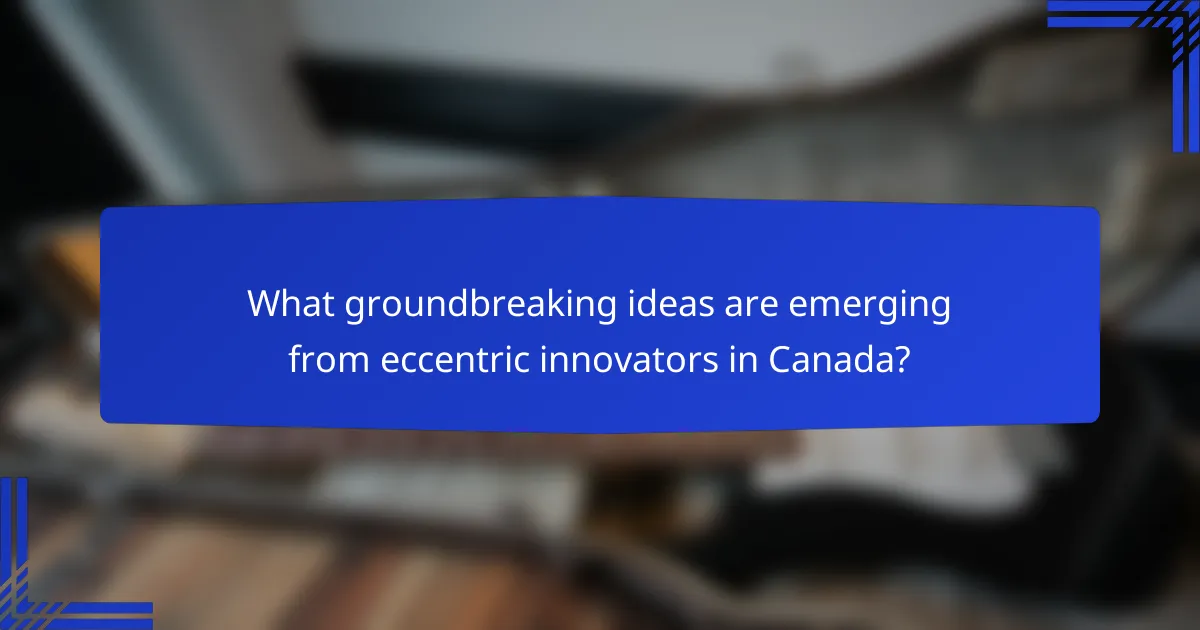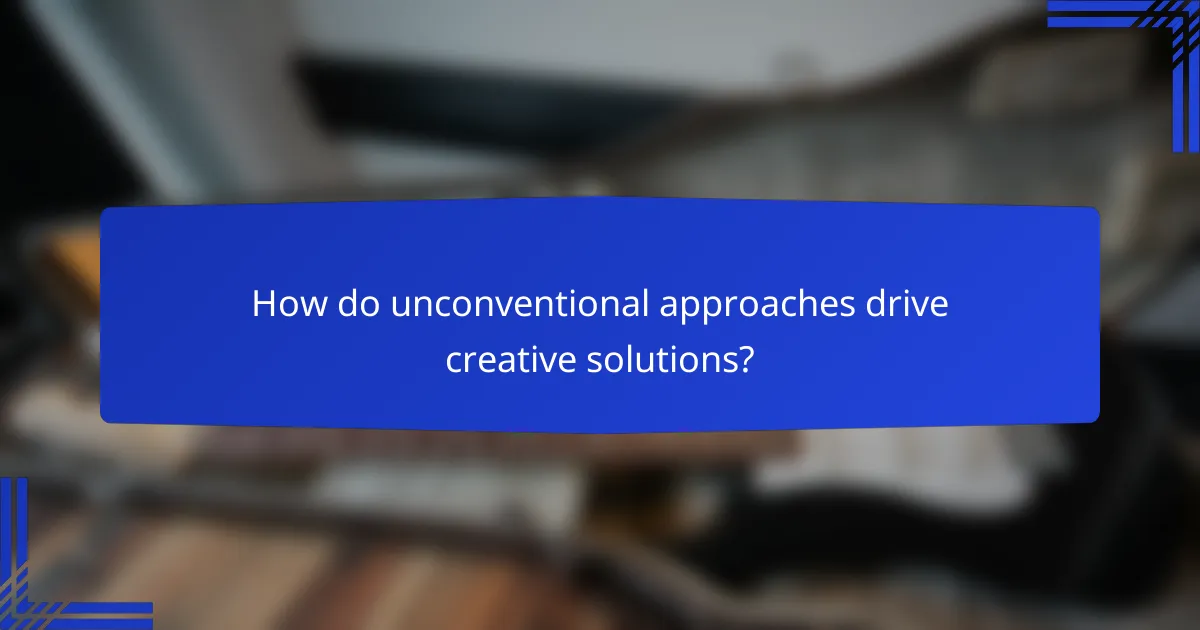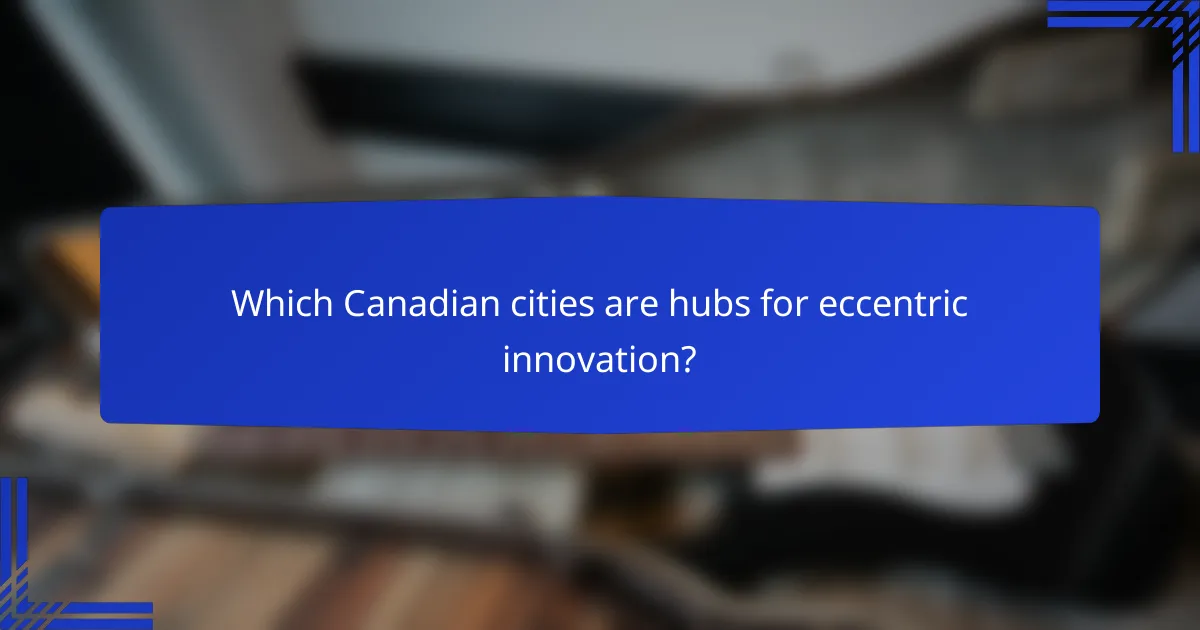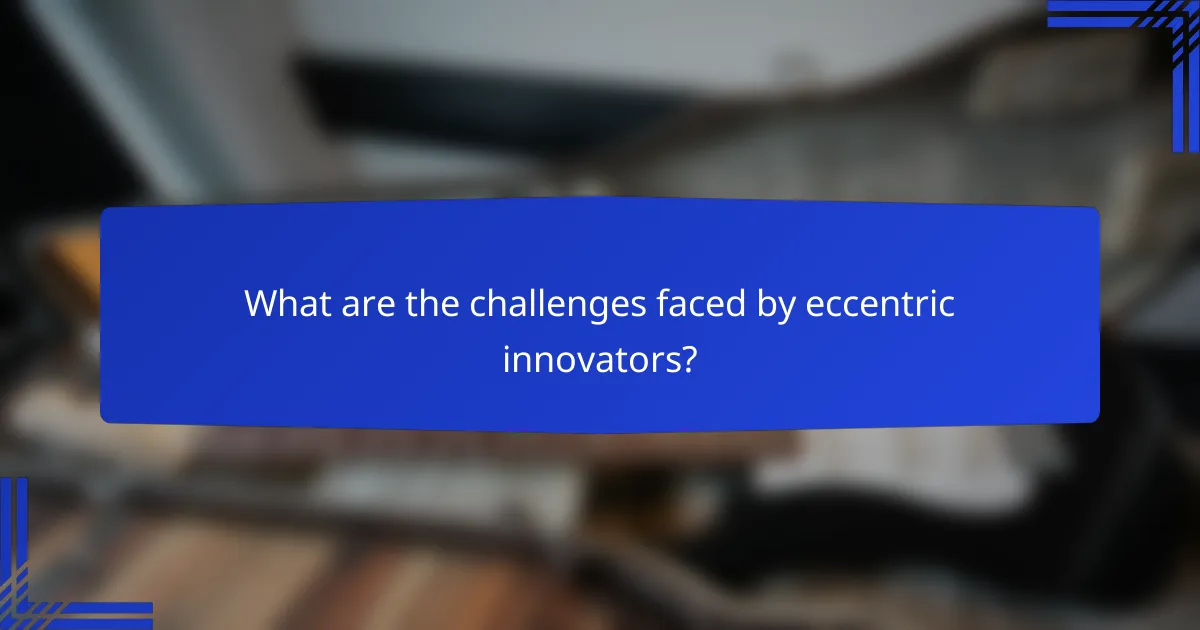Eccentric innovators are reshaping industries with their groundbreaking ideas and unconventional approaches. By embracing creativity and challenging traditional norms, they develop unique solutions that address pressing challenges across technology, community initiatives, and the arts. Their willingness to think outside the box fosters an environment where innovative thinking thrives.

What groundbreaking ideas are emerging from eccentric innovators in Canada?
Eccentric innovators in Canada are driving groundbreaking ideas across various sectors, utilizing unconventional approaches to solve pressing challenges. Their creativity is evident in technology, community initiatives, and the arts, reflecting a diverse range of solutions that often defy traditional norms.
Innovative tech startups
Canada’s tech landscape is thriving with innovative startups that challenge the status quo. Companies are leveraging artificial intelligence, blockchain, and sustainable technologies to create unique products and services. For instance, startups focusing on green tech are developing solutions that reduce carbon footprints while enhancing efficiency.
When considering involvement in these startups, look for those that emphasize scalability and social impact. Engaging with local incubators or tech hubs can provide valuable insights and networking opportunities. Be aware of funding options, as many Canadian startups rely on government grants and venture capital to fuel their growth.
Creative community projects
Community-driven projects in Canada often showcase the ingenuity of local innovators. Initiatives such as urban gardening, community art installations, and skill-sharing workshops foster collaboration and creativity among residents. These projects not only beautify neighborhoods but also build social connections and promote sustainability.
To get involved, consider volunteering or participating in local planning meetings. Successful projects often rely on community input and diverse skill sets, so bringing your expertise can enhance their impact. Keep an eye on local funding opportunities, as many projects seek grants to support their initiatives.
Unconventional art movements
Canada is home to several unconventional art movements that push creative boundaries. Artists are experimenting with mixed media, performance art, and interactive installations that engage audiences in new ways. These movements often address social issues, making art a powerful tool for advocacy and change.
To explore these art movements, visit local galleries or attend art festivals that showcase emerging talent. Engaging with artists and participating in workshops can deepen your understanding of their creative processes. Supporting local artists through purchases or donations can also help sustain these innovative endeavors.

How do unconventional approaches drive creative solutions?
Unconventional approaches foster creative solutions by encouraging innovative thinking and breaking away from traditional norms. These methods promote flexibility and open-mindedness, allowing individuals and teams to explore diverse ideas and perspectives.
Collaboration across disciplines
Collaboration across disciplines combines expertise from various fields to generate unique solutions. By bringing together individuals with different backgrounds—such as technology, art, and science—teams can leverage diverse skills and viewpoints, leading to more innovative outcomes.
For example, a project that involves engineers, designers, and marketers can create a product that not only functions well but also appeals to consumers aesthetically and meets market demands. This cross-pollination of ideas often results in breakthroughs that a single discipline might overlook.
Embracing failure as a learning tool
Embracing failure as a learning tool allows innovators to view setbacks as opportunities for growth. When teams accept that failure is part of the creative process, they are more likely to experiment and take risks, ultimately leading to more effective solutions.
For instance, companies like Google encourage employees to pursue “moonshot” projects, where the goal is to achieve ambitious outcomes, even if it means facing potential failures. This mindset fosters resilience and encourages iterative learning, which can refine ideas and lead to successful innovations.

What are the key characteristics of successful eccentric innovators?
Successful eccentric innovators are often defined by their willingness to challenge norms and explore unconventional ideas. They possess a unique blend of creativity, resilience, and a strong desire to solve problems in new ways.
Risk-taking mindset
A risk-taking mindset is essential for eccentric innovators, allowing them to embrace uncertainty and pursue bold ideas. This involves not only accepting the possibility of failure but also viewing setbacks as opportunities for learning and growth.
To cultivate a risk-taking mindset, innovators should start by setting small, manageable goals that push their boundaries. For instance, experimenting with new approaches in a low-stakes environment can help build confidence and resilience. It’s crucial to balance risk with informed decision-making, ensuring that the potential rewards justify the risks involved.
Unique problem-solving skills
Unique problem-solving skills enable eccentric innovators to approach challenges from different angles. They often employ creative thinking techniques, such as brainstorming or lateral thinking, to generate innovative solutions that others might overlook.
To enhance problem-solving abilities, innovators can practice techniques like mind mapping or reverse engineering existing solutions. Collaborating with diverse teams can also spark new ideas and perspectives, leading to more effective solutions. It’s important for innovators to remain open-minded and flexible, adapting their strategies as new information arises.

Which Canadian cities are hubs for eccentric innovation?
Toronto and Vancouver stand out as key Canadian cities fostering eccentric innovation through their vibrant ecosystems that embrace unconventional ideas and creative solutions. These urban centers attract diverse talent and resources, making them ideal for innovators seeking to challenge the status quo.
Toronto’s tech scene
Toronto’s tech scene is characterized by a blend of startups and established companies that prioritize creativity and innovation. The city is home to numerous incubators and accelerators, such as MaRS Discovery District, which support entrepreneurs with funding, mentorship, and networking opportunities.
In recent years, Toronto has seen a surge in sectors like artificial intelligence and fintech, driven by its diverse talent pool and strong academic institutions. Innovators often collaborate across disciplines, leading to groundbreaking ideas that push technological boundaries.
Vancouver’s creative industries
Vancouver is renowned for its creative industries, particularly in film, gaming, and design. The city benefits from a stunning natural backdrop that inspires artistic expression and attracts creative professionals from around the globe. Organizations like Creative BC provide resources and support for local artists and entrepreneurs.
The gaming sector in Vancouver is especially vibrant, with numerous studios producing award-winning titles. This environment encourages experimentation and unconventional approaches, allowing creators to explore new narratives and technologies, ultimately leading to innovative solutions in entertainment.

How can businesses leverage unconventional approaches for growth?
Businesses can leverage unconventional approaches for growth by embracing innovative strategies that challenge traditional norms. This can lead to unique solutions, increased creativity, and a competitive edge in the market.
Implementing design thinking
Design thinking is a problem-solving approach that prioritizes user experience and empathy. By focusing on understanding the needs and pain points of customers, businesses can create products and services that resonate more deeply with their target audience.
To implement design thinking, companies should follow a five-step process: empathize, define, ideate, prototype, and test. This iterative cycle allows for continuous improvement and adaptation based on user feedback. For instance, a tech startup might prototype a new app feature and gather user insights before finalizing the design.
Encouraging a culture of experimentation
Fostering a culture of experimentation involves encouraging teams to test new ideas without the fear of failure. This mindset can lead to innovative solutions and improvements in processes, products, or services.
Businesses can promote experimentation by allocating resources for pilot projects and setting up feedback loops to learn from outcomes. For example, a retail company might experiment with different store layouts to see which maximizes customer engagement. It’s essential to celebrate both successes and failures to reinforce the value of trying new approaches.

What are the challenges faced by eccentric innovators?
Eccentric innovators encounter several challenges that can hinder their groundbreaking ideas and unconventional approaches. Key obstacles include securing funding and resources, as well as facing resistance from traditional sectors that may be reluctant to embrace change.
Funding and resource limitations
Funding is often a significant barrier for eccentric innovators, as their unconventional ideas may not fit traditional investment models. Many investors prefer established concepts with predictable returns, leaving innovators to seek alternative funding sources such as crowdfunding, grants, or angel investors.
Resource limitations can also restrict the development of innovative projects. Innovators should consider leveraging partnerships with organizations that share similar goals or utilizing co-working spaces to minimize costs. Networking within innovation hubs can provide access to valuable resources and support.
Resistance to change in traditional sectors
Innovators frequently face pushback from established industries that are hesitant to adopt new ideas. This resistance can stem from fear of disruption, potential loss of market share, or simply a preference for the status quo. Understanding the concerns of these sectors is crucial for navigating this challenge.
To overcome resistance, eccentric innovators should focus on demonstrating the value of their ideas through pilot programs or case studies. Building relationships with key stakeholders and effectively communicating the benefits of change can help facilitate acceptance and integration of innovative solutions.

What lessons can we learn from successful eccentric innovators?
Successful eccentric innovators often teach us the value of thinking differently and embracing unconventional approaches. Their groundbreaking ideas highlight the importance of creativity, resilience, and the willingness to take risks in pursuit of unique solutions.
Embrace creativity and curiosity
Successful eccentric innovators prioritize creativity and curiosity, allowing them to explore uncharted territories. They often ask questions that others overlook, leading to innovative breakthroughs. For example, Steve Jobs encouraged his team to think outside the box, resulting in products like the iPhone that transformed entire industries.
To foster creativity, create an environment that encourages experimentation and open dialogue. Allow team members to express their ideas freely, even if they seem unconventional at first. This can lead to unexpected and valuable insights.
Take calculated risks
Taking calculated risks is a hallmark of successful eccentric innovators. They understand that failure is often a stepping stone to success and are willing to experiment with new ideas. For instance, Elon Musk’s ventures, like SpaceX and Tesla, involved significant risks but have led to revolutionary advancements in technology and transportation.
When considering risks, evaluate potential outcomes and develop contingency plans. This approach helps manage uncertainty while still allowing for innovation. Remember, not every risk will pay off, but the lessons learned can be invaluable.
Learn from failures
Learning from failures is crucial for eccentric innovators. They view setbacks as opportunities for growth rather than as dead ends. Thomas Edison famously stated that he didn’t fail but found thousands of ways that didn’t work, ultimately leading to the invention of the light bulb.
To cultivate a mindset that embraces failure, encourage reflection on what went wrong and how to improve. Create a culture where team members can share their experiences without fear of judgment, fostering resilience and continuous improvement.
Challenge the status quo
Successful eccentric innovators often challenge the status quo, questioning existing norms and practices. This willingness to disrupt conventional thinking can lead to significant advancements. For example, Airbnb transformed the hospitality industry by challenging traditional hotel models.
To effectively challenge the status quo, encourage critical thinking and open discussions about existing practices. Identify areas where improvements can be made and empower team members to propose alternative solutions. This can lead to innovative ideas that drive progress.
